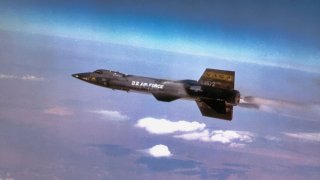X-15: The Air Force's Plan to Hit Mach 6.7 and Shatter Speed Records
The X-15, a marvel of engineering, still claims the records for the highest speed and altitude achieved by a manned aircraft, demonstrating the feasibility of spaceflight beyond traditional rocket launches.
Summary: The X-15, a marvel of engineering, still claims the records for the highest speed and altitude achieved by a manned aircraft, demonstrating the feasibility of spaceflight beyond traditional rocket launches. Despite its achievements, NASA's selection of the Mercury capsule marked a pivotal decision, sidelining the X-15 and shaping the course of American space exploration.
The X-15 Story: How a Rocket Plane Challenged NASA's Capsules for Space Supremacy
Before Mercury astronauts orbited the Earth, or before Gemini astronauts docked with Aegina, or before Apollo astronauts hit golf balls from the moon’s surface, the aerospace community debated the fundamental nature of U.S. space exploration, asking which agency would shuttle Americans to space, and within what type of craft would Americans be shuttled?
The U.S. Air Force, conceptually an appropriate candidate for U.S. space exploration, believed that it should take astronauts into space, rather than the neophyte NACA (soon to be renamed NASA). And according to the Air Force, masters of manned flight, U.S. astronauts should travel to space in a winged aircraft, rather than a capsule launched atop a rocket. The capsule scheme—which offered to cram a “pilot” into a man-sized capsule and launch him to space aboard a rocket before allowing him to parachute back to the Earth’s surface—was offensive to the Air Force, who preferred to allow their pilots to take off and land under their own authority.
The Air Force’s answer to the “spam in a can” capsule ride, the vehicle meant to prove that U.S. astronauts could fly to space, rather than ride to space, was the North American X-15—the fastest—and highest-flying aircraft ever built.
Introducing the X-15
The X-15, technically, is an aircraft. But in many respects, the X-15 is just a rocket with some wings and a cockpit. Built around the Reaction Motors XLR99, the X-15 was uniquely powerful; the XLR99 was capable of generating about 60,000 pounds of thrust with its mixture of anhydrous ammonia and liquid oxygen. The XLR99’s fuel consumption was fairly rocket-like, burning 7.5 tons of fuel in just 80 seconds.
The voracious fuel consumption served a purpose: blinding speed. The X-15 still holds the airspeed record, nearly sixty years after it was set. On October 3rd, 1967, USAF pilot William Knight directed his X-15 to Mach 6.7, or 4.520 miles per hour—the fastest anyone has ever traveled within the Earth’s atmosphere.
The X-15 also holds the altitude record, from August 22, 1963, when an X-15 was flown 67 miles above the surface of the Earth. Bear in mind that a commercial airliner flies at 7 miles above the surface. And bear in mind that the official threshold for space is 50 miles high—so each and every X-15 pilot that exceeded the 50-mile threshold earned his astronaut wings, proving that manned flight into space was indeed a viable option.
X-15: Bypassed in favor of the capsule
Of course, NASA was ultimately chosen to shuttle astronauts to space. And NASA did not pursue manned space flight, either in the X-15 or the canceled X-20, but in a capsule. Specifically, NASA chose the Mercury capsule as the first vessel of U.S. space exploration, although the X-15 was considered; Air Force and NACA officials did debate the merits of launching an X-15 to space aboard an SM-64 Navaho missile. While the X-15/SM-64 configuration was never tried, the arrangement foreshadowed the Space Shuttle configuration that would dominate U.S. space flight for a generation.
About the Author: Harrison Kass
Harrison Kass is a defense and national security writer with over 1,000 total pieces on issues involving global affairs. An attorney, pilot, guitarist, and minor pro hockey player, Harrison joined the US Air Force as a Pilot Trainee but was medically discharged. Harrison holds a BA from Lake Forest College, a JD from the University of Oregon, and an MA from New York University. Harrison listens to Dokken.


